VISL User's Guide
The EPA's Vapor Intrusion Screening Level (VISL) Calculator User's Guide for Chemical Contaminants provides descriptions, equations, and default exposure parameters used to calculate the risk-based VISLs. Additional guidance is also provided on sources of parameters and proper VISL use.
This tool provides screening level concentrations for groundwater, soil gas ( target sub-slab and near source), and indoor air to assist Agency staff with making a vapor intrusion screening levels (VISL) determination based on limited, initial data. In addition to calculating screening levels, this tool can calculate indoor air concentrations from soil gas and groundwater concentrations entered by the user. The risks from calculated indoor air concentrations and user-provided indoor air concentrations can also be calculated. The equations for these features are presented in the following sections.
It is suggested that users read the VISL FAQ page before using the calculator. Before proceeding through the user's guide please read the Disclaimer.
You may need a PDF reader to view some of the files on this page. See EPA’s About PDF page to learn more.
On this page:
Disclaimer
1. General Requirements for VISL Calculations
1.1 Toxicity Values Hierarchy
1.2 Chemical-specific Parameters Hierarchy
2. Vapor Intrusion Screening Level Equations
2.1 Air Screening Level Equations
2.2 Groundwater Screening Level Equation
2.3 Soil Gas Screening Level Equation
2.4 Vapor Intrusion Screening Level Supporting Equation
3. Indoor Air Concentration and Risk Calculation Equations
3.1 Indoor Air Concentration Derived from Soil Gas Concentration Equation
3.2 Indoor Air Concentration Derived from Groundwater Concentration Equation
3.3 Calculation of Risks and Hazards from Indoor Air Concentrations
4. Modifications of Standard Equations
4.1 Using Units in ppb
4.2 Modifications of Groundwater Temperatures
5. Recommended Default Exposure Parameters
6. References
Disclaimer
This guide sets forth a recommended, but not mandatory, approach based upon currently available information with respect to risk assessment at sites. This document does not establish binding rules. Alternative approaches for risk assessment may be found to be more appropriate at specific sites (e.g., where site circumstances do not match the underlying assumptions, conditions and models of the guidance). The decision whether to use an alternative approach and a description of any such approach should be documented for such sites. Accordingly, when comments are received at individual sites questioning the use of the approaches recommended in this guidance, the comments should be considered and an explanation provided for the selected approach.
It should also be noted that the vapor intrusion screening levels (VISLs) produced by this calculator are based upon human health risk and do not address potential ecological risk. Some sites in sensitive ecological settings may also need to be evaluated for potential ecological risk. EPA's guidance "Ecological Risk Assessment Guidance for Superfund: Process for Designing and Conducting Ecological Risk Assessment" contains an eight step process for using benchmarks for ecological effects in the remedy selection process.
1. General Requirements for VISL Calculations
The chemical first must meet the criteria for volatility which is either a Vapor Pressure > 1 mm Hg, or a Henry's Law Constant > 1 × 10-5 atm-m3/mol. If those parameters are not available, then the chemical can not be assessed for vapor intrusion. Second, the chemical must be sufficiently volatile and toxic to pose inhalation risk via vapor intrusion from soil source. This is determined by calculating the chemicals pure phase vapor concentration. The pure phase vapor concentration must be greater than the air screening level. The pure phase vapor concentration is calculated based on an equation involving vapor pressure (VP) and molecular weight (MW). VP and MW need to be available to calculate pure phase vapor pressure and hence a VISL. Third, the chemical must be sufficiently volatile and toxic to pose inhalation risk via vapor intrusion from groundwater. This is determined by calculating the groundwater vapor concentration. The groundwater vapor concentration must be greater than the air screening level. The groundwater vapor concentration is calculated based on an equation involving pure component water solubility (S) and Henry's Law Constant (HLC). S and HLC need to be available to calculate groundwater vapor concentration and hence a VISL. Finally, the chemical must contain either a reference concentration (RfC) on an inhalation unit risk (IUR) for a VISL to be calculated.
The medium-specific VISLs for health protection are developed considering a generic conceptual model for vapor intrusion consisting of:
- A source of vapors underneath the building(s) either in the vadose zone or in the uppermost, continuous zone of groundwater.
- Vapor migration via diffusion upwards through unsaturated soils from these sources toward the ground surface and overlying buildings.
- Buildings with poured concrete foundations (e.g., basement or slab-on-grade foundations) that are susceptible to soil gas entry.
A critical assumption for this generic model is that site-specific subsurface characteristics will tend to reduce or attenuate soil gas concentrations as vapors migrate upward from the source and into overlying structures. The VISL relies on default attenuation factors developed from measured VI data. However, some site specific characteristics may result in relatively unattenuated or enhanced transport of vapors into a building. These factors include:
- Significant openings to the subsurface that facilitate soil gas entry into the building (e.g., sumps, unlined crawl spaces, earthen floors) other than typical utility penetrations.
- Very shallow groundwater sources (e.g., depths to water less than five feet below foundation level).
- Significant routes for preferential, subsurface vapor migration whether naturally occurring (e.g., fractured bedrock) or anthropogenic routes.
These specific factors are likely to render inappropriate the use of the recommended attenuation factors and the target sub-slab, groundwater, and soil gas VISLs for purposes of identifying sites or buildings unlikely to pose a health concern through the vapor intrusion pathway. On the other hand, further evaluation of the vapor intrusion pathway is still appropriate when the target sub-slab, groundwater, and soil gas VISLs are exceeded for samples from a building or site where these specific factors are present.
In addition, certain vapor sources, listed below, invalidate the recommended attenuation factors and screening levels used the VISL:
- Those originating in landfills where methane is generated in sufficient quantities to induce advective transport in the vadose zone.
- Those originating in commercial or industrial settings where vapor-forming chemicals can be released within an enclosed space and the density of the chemicals' vapor may result in significant advective transport of the vapors downward through cracks and openings in floors and into the vadose zone.
- Leaking vapors from pressurized gas transmission lines.
In each case, the diffusive transport of vapors may be overridden by advective transport, and the vapors may be transported in the vadose zone several hundred feet from the source of contamination with little attenuation in concentration.
1.1 Toxicity Values Hierarchy
The toxicity values used in the VISL calculator follow the same hierarchy as used in the EPA's Regional Screening Levels for Chemical Contaminants at Superfund Sites (RSL) calculator. Details of the toxicity value hierarchy can be found in section 2.3 of the RSL User's Guide. Below is a brief description of the toxicity hierarchy.
In 2003, EPA's Superfund program revised its hierarchy of human health toxicity values, providing three tiers of toxicity values in a memo (PDF) (4 pp, 225 K). Three tier 3 sources were identified in that guidance, but it was acknowledged that additional tier 3 sources may exist. The 2003 guidance did not attempt to rank or put the identified tier 3 sources into a hierarchy of their own. However, when developing the calculator presented on this website, EPA needed to establish a hierarchy among the tier 3 sources. The toxicity values used as “defaults” in this calculator are consistent with the 2003 guidance.
Users of this calculator wishing to consider using other toxicity values, including toxicity values from additional sources, may find the discussions and seven preferences on selecting toxicity values in the attached Environmental Council of States paper useful for this purpose (ECOS website Exit, ECOS paper(DOC)).
When using toxicity values other than tier 1, users are encouraged to carefully review the basis for the value and to document its use in decision documentation on a site.
1.2 Chemical-specific Parameters Hierarchy
The chemical-specific parameter values used in the VISL calculator follow the same hierarchy as used in the EPA's Regional Screening Levels for Chemical Contaminants at Superfund Sites calculator. Details of the chemical-specific parameter hierarchy can be found in section 2.4 of the RSL User's Guide. Below is a brief description of the chemical-specific parameter hierarchy.
Several chemical specific parameters are needed for development of the VISLs. Many sources are used to populate the database of chemical-specific parameters. Generally, the hierarchies presented are suitable for organic and inorganic compounds.
The only parameter presented in the VISL that is not presented in the RSL is the Lower Explosive Limit (LEL % by volume). The hierarchy for this parameter is as follows: CRC; Yaws Experimental; Yaws Extrapolated; Yaws Estimated.
2. Vapor Intrusion Screening Level Equations
This section presents the three screening levels: air, groundwater and soil gas.
2.1 Air Screening Level Equations
The user can select target cancer risk (TCR), target hazard quotient (THQ) and either a resident or worker receptor.
2.1.1 Resident Air Equations
These are the equations for determining the protective resident air concentrations. The exposure parameter variables are defined in Table 1.
- Noncarcinogenic
Inhalation

- Carcinogenic
Inhalation

- Mutagenic
Inhalation
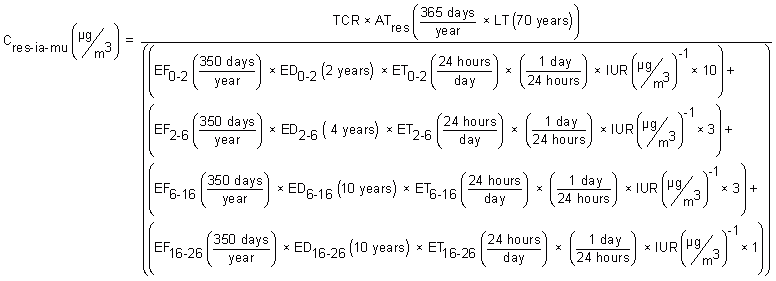
- Vinyl Chloride
Inhalation

- Trichloroethylene
Inhalation
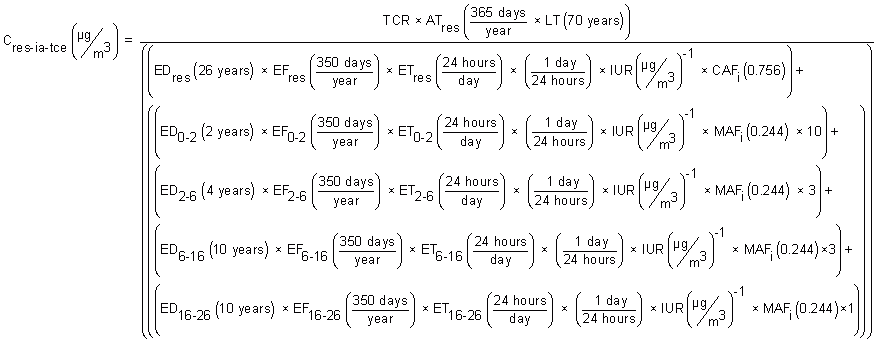
- Trichloroethylene Supporting Equation
Since TCE requires the use of different toxicity values for cancer and mutagen equations, it was decided to make a toxicity value adjustment factor for cancer (CAF) and mutagens (MAF). The adjustments were done for oral (o) and inhalation (i). The equations used are presented below. The adjustment factors are based on the adult-based toxicity values and these are the cancer toxicity values presented in the Generic Tables.
Inhalation

2.1.2 Worker Air Equations
These are the equations for determining the protective industrial air concentrations. The exposure parameter variables are defined in Table 1.
- Noncarcinogenic
Inhalation
- Carcinogenic
Inhalation
2.2 Groundwater Screening Level Equation
This equation is used to determine the groundwater concentration protective of exposure to indoor air. The equation uses a groundwater attenuation factor and H'. For a groundwater source, a chemical is considered sufficiently volatile and toxic to pose an inhalation risk through vapor intrusion if the vapor concentration (calculated using the chemical's Henry's Law Constant at the groundwater temperature) corresponding to the chemical's solubility limit in water, is greater than the target indoor air concentration. The groundwater attenuation factor is not considered in this comparison, although it is considered in the subsequent calculation of the target groundwater concentration. The target groundwater concentration corresponding to a chemical's target indoor air concentration is calculated by dividing the target indoor air concentration by an attenuation factor of 0.001 and then converting the vapor concentration to an equivalent groundwater concentration, assuming equilibrium between the aqueous and vapor phases at the water table. The equilibrium partitioning is assumed to obey Henry's Law. The exposure parameter variables are defined in Table 1.
- Groundwater Screening Level

2.3 Soil Gas Screening Level Equation
This equation is used to determine the soil gas concentration protective of exposure to indoor air. The equation uses a soil gas attenuation factor. The soil gas attenuation factor used in the calculations is 0.03, which is the generic attenuation factor used for target sub-slab gas in the 2002 draft vapor intrusion guidance. This attenuation factor is used for all soil gas data, as additional information collected after development of the 2002 draft vapor intrusion guidance (EPA 2002) suggests that external soil gas samples need to be evaluated as conservatively as target sub-slab gas samples (EPA 2010). The exposure parameter variables are defined in Table 1.
- Soil Gas Screening Level

2.4 Vapor Intrusion Screening Level Supporting Equation
Chemical's must be sufficiently volatile and toxic to pose inhalation risk via vapor intrusion from soil and groundwater sources. This is determined by calculating the chemicals pure phase vapor concentration and the groundwater vapor concentration. The soil gas vapor concentration and the groundwater vapor concentration must be greater than the air screening level to determine a VISL.
The pure phase vapor pressure equation is presented here. The exposure parameter variables are defined in Table 1.
- Pure Phase Vapor Concentration

The groundwater vapor concentration equation is presented here. The exposure parameter variables are defined in Table 1.
- Groundwater Vapor Concentration

3. Indoor Air Concentration and Risk Calculation Equations
This section presents the equations used to calculate the indoor air concentration and risk from the user-provided soil gas and/or groundwater concentration. Data used for screening and the calculation of risk should be of sufficient quality. For further information on data quality needs see OSWER TECHNICAL GUIDE FOR ASSESSING AND MITIGATING THE VAPOR INTRUSION PATHWAY FROM SUBSURFACE VAPOR SOURCES TO INDOOR AIR section 5.5.
3.1 Indoor Air Concentration Derived from Soil Gas Concentration Equation
This section presents the equation used to calculate the indoor air concentration from the user-provided soil gas concentration. The exposure parameter variables are defined in Table 1.
-
Calculated Indoor Air Concentration from Soil Gas

3.2 Indoor Air Concentration Derived from Groundwater Concentration Equation
This section presents the equation used to calculate the indoor air concentration from the user-provided groundwater concentration. The exposure parameter variables are defined in Table 1.
-
Calculated Indoor Air Concentration from Groundwater

3.3 Calculation of Risks and Hazards from Indoor Air Concentrations
This section presents the chronic daily intake equations used to calculate the risk from indoor air concentrations. The exposure parameter variables are defined in Table 1.
-
Excess Lifetime Cancer Risk

-
Hazard Quotient

3.3.1 Resident Air CDI Equations
The exposure parameter variables are defined in Table 1.
- Chronic Daily Intake Resident Noncarcinogenic

-
Chronic Daily Intake Resident Carcinogenic

-
Chronic Daily Intake Resident Mutagenic
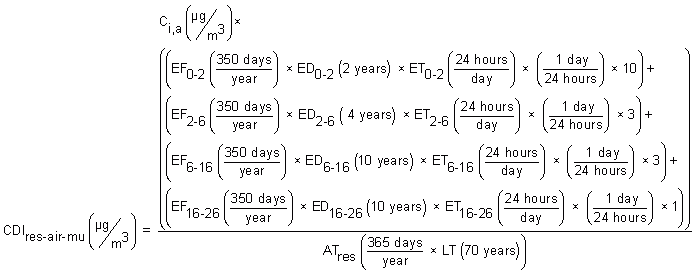
- Chronic Daily Intake Resident Vinyl Chloride

- Chronic Daily Intake Resident Trichloroethylene
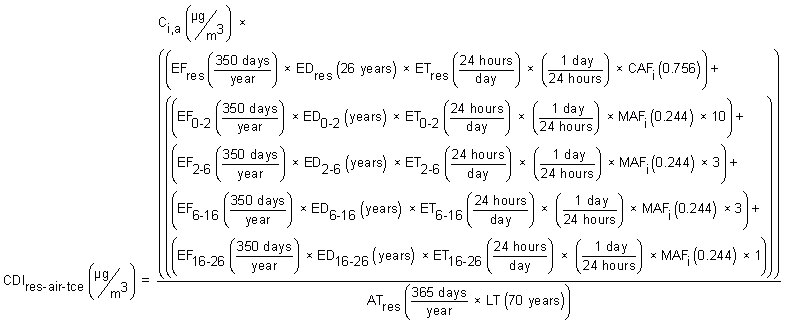
- Trichloroethylene Supporting Equation
Inhalation

3.3.2 Worker Air CDI Equations
The exposure parameter variables are defined in Table 1.
- Chronic Daily Intake Industrial Worker Noncarcinogenic

- Chronic Daily Intake Industrial Worker Carcinogenic

4. Modifications of Standard Equations
The sections below present the conversions for modifying the standard equations. Conversion of units into parts per billion (ppb) and modifying Henry's Law constant for temperature are presented.
4.1 Using Units in ppb
The vapor concentrations in the VISL Calculator are given in units of micrograms per cubic meter (µg/m3). Although the VISL Calculator uses these units for all vapor concentrations, some users may have results in parts per billion by volume (ppbv). The conversion from ppbv to µg/m3 is:
- ppb Unit Conversion
The exposure parameter variables are defined in Table 1.

4.2 Modifications of Groundwater Temperatures
The exposure parameter variables are defined in Table 1. Users are given the option to the change groundwater temperature from the default of 25°C to a site-specific value. Since the unitless Henry's Law Constant (H') is derived based on the partial pressure of a gas in equilibrium with a liquid and the equilibrium changes when temperature changes, H' is changed to reflect the equilibrium at the given temperature. The equation below illustrates how H' is derived when groundwater temperature is changed. An EPA Fact Sheet describing the process can be found at https://19january2021snapshot.epa.gov/vaporintrusion/fact-sheet-correcting-henrys-law-constant-temperature.
When changing the groundwater-soil system temperature, the criteria that determines whether a chemical is volatile or not may also change. The Henry’s Law constants and vapor pressures that are used in VISL calculations are based on standard laboratory conditions of 25°C. When the groundwater-soil system temperature is changed, the Henry’s Law constants and vapor pressures will change accordingly. A volatile chemical at 25°C may not be volatile at a lower temperature. Conversely, a nonvolatile may become volatile at temperatures above 25°C. When the groundwater-soil system temperature is changed the VISL calculator will provide the user with recalculated Henry's Law constants and vapor pressures. These values can be compared to the volatility status requirements presented in section 1. The VISL calculator does not automatically change the volatility status of a chemical to reflect the user's change of the groundwater-soil system temperature. In site-specific user-provided mode of the calculator, the user may change the volatility status of a chemical if deemed appropriate by the user’s regional risk assessor.
- To Determine Henry's Law Constant at a Groundwater Temperature other than 25° Celsius
![]()
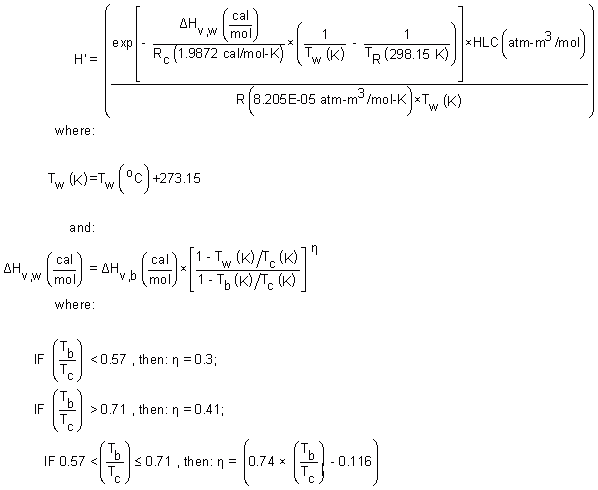
- To Determine Henry's Law Constant at a Groundwater Temperature of 25° Celsius

- To Determine Vapor Pressure at a Groundwater Temperature other than 25° Celsius
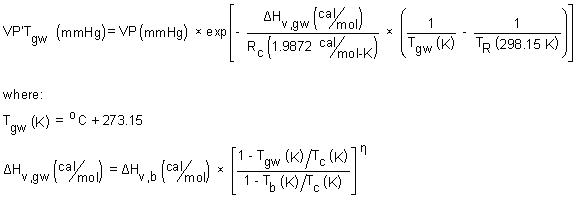
- To Determine Pure Phase Vapor Concentration at a Groundwater Temperature other than 25° Celsius

5. Recommended Default Exposure Parameters
Table 1 presents the definitions of the variables and their default values. The VISL default values and exposure models are consistent with the RSL calculator. Both the RSL and VISL calculator default values are consistent where the same pathways are addressed. This calculator follows the recommendations in the OSWER Directive concerning use of exposure parameters from the 2011 Exposure Factors Handbook. Any alternative values or assumptions used in remedy evaluation or selection on a CERCLA site should be presented with supporting rationale in Administrative Records.
Table 1. Recommended Default Exposure Parameters
| Symbol | Definition (units) | Default | Reference |
|---|---|---|---|
|
Screening Levels (C)
|
|||
| Cres-ia-ca | Resident Air Carcinogenic (µg/m3) | Contaminant-specific | Determined in this calculator |
| Cres-ia-nc | Resident Air Noncarcinogenic (mg/m3) | Contaminant-specific | Determined in this calculator |
| Cres-ia-mu | Resident Air Mutagenic (µg/m3) | Mutagen-specific | Determined in this calculator |
| Cres-ia-tce | Resident Air Carcinogenic Trichloroethylene (µg/m3) | Trichloroethylene-specific | Determined in this calculator |
| Cres-ia-vc | Resident Air Carcinogenic Vinyl Chloride (µg/m3) | Vinyl Chloride-specific | Determined in this calculator |
| Cw-ia-ca | Worker Air Carcinogenic (µg/m3) | Contaminant-specific | Determined in this calculator |
| Cw-ia-nc | Worker Air Noncarcinogenic (mg/m3) | Contaminant-specific | Determined in this calculator |
| Ci,a,Target | Target Indoor Air (µg/m3) | Contaminant-specific | Determined in this calculator |
| Csg,Target | Target Soil Gas (ug/m3) | Contaminant-specific | Determined in this calculator |
| Cgw,Target | Target Groundwater (ug/L) | Contaminant-specific | Determined in this calculator |
|
Chronic Daily Intakes (CDIs)
|
|||
| CDIres-air-ca | Resident Air Carcinogenic (µg/m3) | Contaminant-specific | Determined in this calculator |
| CDIres-air-nc | Resident Air Noncarcinogenic (mg/m3) | Contaminant-specific | Determined in this calculator |
| CDIres-air-mu | Resident Air Mutagenic (µg/m3) | Mutagen-specific | Determined in this calculator |
| CDIres-air-tce | Resident Air Carcinogenic Trichloroethylene (µg/m3) | Trichloroethylene-specific | Determined in this calculator |
| CDIres-air-vc | Resident Air Carcinogenic Vinyl Chloride (µg/m3) | Vinyl Chloride-specific | Determined in this calculator |
| CDIw-air-ca | Worker Air Carcinogenic (µg/m3) | Contaminant-specific | Determined in this calculator |
| CDIw-air-nc |
Worker Air Noncarcinogenic (mg/m3) |
Contaminant-specific | Determined in this calculator |
|
Toxicity Values
|
|||
| RfC | Chronic Inhalation Reference Concentration (mg/m3) | Contaminant-specific | EPA Superfund hierarchy |
| IUR | Chronic Inhalation Unit Risk (µg/m3)-1 | Contaminant-specific | EPA Superfund hierarchy |
|
Miscellaneous Variables
|
|||
| TCR | Target Cancer Risk | 1 x 10-6 | Selected by user |
| THQ | Target Hazard Quotient | 0.1 | Selected by user |
| HQ | Hazard Quotient | Contaminant-specific | Determined in this calculator |
| ELCR | Excess Lifetime Cancer Risk | Contaminant-specific | Determined in this calculator |
| CDI | Chronic Daily Intake | Contaminant-specific | Determined in this calculator |
| ATw | Worker Averaging Time - Carcinogenic (days/year) | 365 | U.S. EPA 1989 (pg. 6-23) |
| ATw-a | Worker Averaging Time - Noncarcinogenic (days/year) | 365 | U.S. EPA 1989 (pg. 6-23) |
| ATres | Resident Averaging Time - Carcinogenic (days/year) | 365 | U.S. EPA 1989 (pg. 6-23) |
| ATres-a | Resident Averaging Time - Noncarcinogenic (days/year) | 365 | U.S. EPA 1989 (pg. 6-23) |
| LT | Lifetime (years) | 70 | U.S. EPA 1989 (pg. 6-22) |
| ΔHv,b | Enthalpy of vaporization at the normal boiling point (cal/mol) | Contaminant-specific | See Chemical-specific hierarchy |
| ΔHv,gw | Enthalpy of vaporization at temperature of groundwater (cal/mol) | Contaminant-specific | Determined in this calculator |
| HLC | Henry's Law Constant at 25°C (atm-m3per mole) | Contaminant-specific | See Chemical-specific hierarchy |
| H' | Dimensionless Henry's Law Constant at 25°C (unitless) | Contaminant-specific | See Chemical-specific hierarchy |
| HLCTgw | Henry's Law Constant for Groundwater Temperatures other than 25°C (atm-m3per mole) | Contaminant-specific | See Chemical-specific hierarchy |
| H'Tgw | Dimensionless Henry's Law Constant for Groundwater Temperatures other than 25°C | Contaminant-specific | See Chemical-specific hierarchy |
| T | Absolute Temperature (Kelvin) | 298.15 | Equivalent to 25° C |
| Tgw | Groundwater Temperatures (Kelvin) | Site-specific | User-provided |
| Tc | Critical Temperatures (Kelvin) | Contaminant-specific | See Chemical-specific hierarchy |
| Tb | Normal Boiling Point (Kelvin) | Contaminant-specific | See Chemical-specific hierarchy |
| n | If (Tb/Tc < 0.57) If (Tb/Tc > 0.71) If (0.57 < Tb/Tc ≤ 0.71) |
n = 0.3 n = 0.41 n = (0.74 x Tb/Tc - 0.116) |
U.S. EPA Fact Sheet |
| S | Water Solubility Limit (mg/L) | Contaminant-specific | See Chemical-specific hierarchy |
| VP | Vapor Pressure @ 25°C (mmHg) | Contaminant-specific | See Chemical-specific hierarchy |
| VPTgw | Vapor Pressure at Groundwater Temperature (mmHg) | Contaminant-specific | Determined in this calculator |
| R | Universal Gas Constant (L-atm/mole-K) | 0.082057 | U.S. EPA Fact Sheet |
| Rc | Universal Gas Constant (cal/mole-K) | 1.9872 | U.S. EPA Fact Sheet |
| MW | Molecular Weight (g/mole) | Contaminant-specific | See Chemical-specific hierarchy |
| AFss | Attenuation Factor Target Sub-Slab (unitless) | 0.03 | U.S. EPA VISL 2014 |
| AFgw | Attenuation Factor Groundwater (unitless) | 0.001 | U.S. EPA VISL 2014 |
| CAFi | Cancer Adjustment Factor Inhalation (unitless) | 0.756 | Determined in this calculator |
| MAFi | Mutagenic Adjustment Factor Inhalation (unitless) | 0.244 | Determined in this calculator |
| LEL | Lower Explosive Limit (% by volume) | Contaminant-specific | See Chemical-specific hierarchy |
| C | Concentration (g/m3) | Contaminant-specific | Determined in this calculator |
| Cppbv | Concentration in parts per billion by volume (ppbv) | Contaminant-specific | User-provided |
| Cvp | Pure Phase Vapor Concentration (µg/m3) | Contaminant-specific | Determined in this calculator |
| CvpTgw | Pure Phase Vapor Concentration at Groundwater Temperature (µg/m3) | Contaminant-specific | Determined in this calculator |
| Csv | Soil Vapor Concentration (g/cm3-v) | Contaminant-specific | Determined in this calculator |
| Cw | Water Vapor Concentration (g/cm3-w) | Contaminant-specific | Determined in this calculator |
| Chc | Groundwater Vapor Concentration (µg/m3) | Contaminant-specific | Determined in this calculator |
| Cgw | Groundwater Concentration (µg/L) | Contaminant-specific | Entered by user |
| Csg | Soil Gas Concentration (µg/m3) | Contaminant-specific | Entered by user |
| Ci,a | Indoor Air Concentration (µg/m3) | Contaminant-specific | Entered by user |
| ADAF0-2 | Age-Dependent Adjustment Factor - age segment 0-2 (year) | 10 | U.S. EPA 2005 (pg. 37) |
| ADAF2-6 | Age-Dependent Adjustment Factor - age segment 2-6 (year) | 3 | U.S. EPA 2005 (pg. 37) |
| ADAF6-16 | Age-Dependent Adjustment Factor - age segment 6-16 (year) | 3 | U.S. EPA 2005 (pg. 37) |
| ADAF16-26 | Age-Dependent Adjustment Factor - age segment 16-26 (year) | 1 | U.S. EPA 2005 (pg. 37) |
|
Exposure Frequency, Exposure Duration, and Exposure Time Variables
|
|||
| EFres | Resident Exposure Frequency (days/year) | 350 | U.S. EPA 1991a (pg. 15) |
| EFw | Worker Exposure Frequency (days/year) | 250 | U.S. EPA 1991a (pg. 15) |
| EF0-2 | Exposure Frequency - age segment 0-2 (days/year) | 350 | U.S. EPA 1991a (pg. 15) |
| EF2-6 | Exposure Frequency - age segment 2-6 (days/year) | 350 | U.S. EPA 1991a (pg. 15) |
| EF6-16 | Exposure Frequency - age segment 6-16 (days/year) | 350 | U.S. EPA 1991a (pg. 15) |
| EF16-26 | Exposure Frequency - age segment 16-26 (days/year) | 350 | U.S. EPA 1991a (pg. 15) |
| EDres | Resident Exposure Duration (year) | 26 | EPA 2011, Table 16-108; 90th percentile for current residence time. |
| EDres-c | Resident Exposure Duration - child (year) | 6 | U.S. EPA 1991a (pg. 15) |
| EDres-a | Resident Exposure Duration - adult (year) | 20 | EDr (26 years) - EDc (6 years) |
| EDw | Worker Exposure Duration - (year) | 25 | U.S. EPA 1991a (pg. 15) |
| ED0-2 | Exposure Duration - age segment 0-2 (year) | 2 | EPA 2011, Table 16-108; 90th percentile for current residence time. |
| ED2-6 | Exposure Duration - age segment 2-6 (year) | 4 | EPA 2011, Table 16-108; 90th percentile for current residence time. |
| ED6-16 | Exposure Duration - age segment 6-16 (year) | 10 | EPA 2011, Table 16-108; 90th percentile for current residence time. |
| ED16-26 | Exposure Duration - age segment 16-26 (year) | 10 | EPA 2011, Table 16-108; 90th percentile for current residence time. |
| ETres | Resident Air Exposure Time (hours/day) | 24 | The whole day |
| ETw | Worker Air Exposure Time (hours/day) | 8 | The work day |
| ET0-2 | Exposure Time - age segment 0-2 (hours/day) | 24 | The whole day |
| ET2-6 | Exposure Time - age segment 2-6 (hours/day) | 24 | The whole day |
| ET6-16 | Exposure Time - age segment 6-16 (hours/day) | 24 | The whole day |
| ET16-26 | Exposure Time - age segment 16-26 (hours/day) | 24 | The whole day |
6. References
U.S. EPA (Environmental Protection Agency). 1987. Processes, Coefficients, and Models for Simulation Toxic Organics and Heavy Metals in Surface Waters. EPA/600/3-87/015. Office of Research and Development, Athens, GA.
U.S. EPA 1989. Risk assessment guidance for Superfund. Volume I: Human health evaluation manual (Part A) (PDF) (289 pp, 6.9 MB). Interim Final. Office of Emergency and Remedial Response. EPA/540/1-89/002.
U.S. EPA 1991a. Human health evaluation manual, supplemental guidance: "Standard default exposure factors (PDF)" (28 pp, 248 K). OSWER Directive 9285.6-03.
U.S. EPA 1991b. Risk Assessment Guidance for Superfund, Volume I: Human Health Evaluation Manual (Part B, Development of Risk-Based Preliminary Remediation Goals) (PDF) (68 pp, 721 K). Office of Emergency and Remedial Response. EPA/540/R-92/003. December 1991
U.S. EPA. 1996a. Soil Screening Guidance: User's Guide. Office of Emergency and Remedial Response. Washington, DC. OSWER No. 9355.4-23.
U.S. EPA. 1996b. Soil Screening Guidance: Technical Background Document. Office of Emergency and Remedial Response. Washington, DC. OSWER No. 9355.4-17A
U.S. EPA, 2001. WATER9. Version 1.0.0. Office of Air Quality Planning and Standards, Research Triangle Park, NC. Document (PDF) (38 pp, 185 K) and Website.
U.S. EPA 2002. Supplemental Guidance for Developing Soil Screening Levels for Superfund Sites. OSWER 9355.4-24. December 2002. Website
U.S. EPA 2004. Risk Assessment Guidance for Superfund Volume I: Human Health Evaluation Manual (Part E, Supplemental Guidance for Dermal Risk Assessment) Final. OSWER 9285.7-02EP.July 2004. Document (PDF) (186 pp, 4.2 MB) and Website
U.S. EPA 2005. Supplemental Guidance for Assessing Susceptibility from Early-Life Exposure to Carcinogens. March 2005. Document (PDF) (166 pp, 468 K)
U.S. EPA 2009. Risk Assessment Guidance for Superfund Volume I: Human Health Evaluation Manual (Part F, Supplemental Guidance for Inhalation Risk Assessment) Final. OSWER 9285.7-82. January 2009. Document (PDF)(68 pp, 724 K), memo (PDF) (3 pp, 487 K) and Website
U.S. EPA 2011. Exposure Factors Handbook 2011 Edition (Final). National Center for Environmental Assessment, Office of Research and Development. Washington D.C. Currently available online at this Website or download here (PDF) (1,436 pp, 21.3 MB).
U.S. EPA VISL 2014. Vapor Intrusion Screening Level (VISL) Calculator User's Guide. May 2014. Document (PDF) (7 pp, 1.1 MB)
